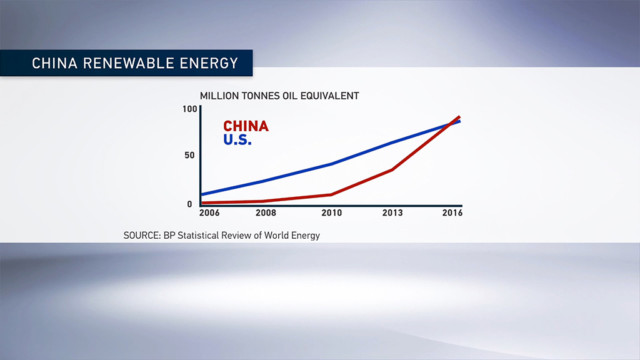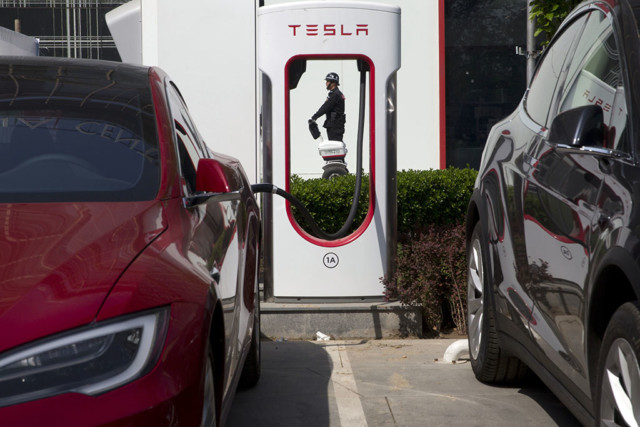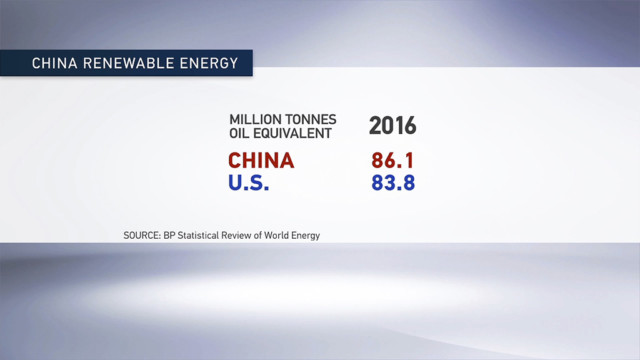Qinghai Province in northwest China ran entirely on renewable energy last month. According to Chinese officials, 100 percent of Qinghai’s energy came from wind, solar and hydro power stations.
The trial run is just the latest effort by the world’s most populous country to transition to clean energy.
CGTN’s Roee Ruttenberg reports.
China’s plan includes a nearly $400 million investment in renewables by the year 2020. China’s National Energy Administration estimates that the money will create 13 million jobs in the country.
Over the last few years, more production has led to more consumption. That may help explain why last year, China overtook the United States as the world’s largest consumer of renewable power.
In a new report from BP, entitled Statistical Review of World Energy, the global energy giant notes that in 2016, China consumed the oil-equivalent of 86.1 million metric tonnes. The U.S. consumed slightly less.
While both countries have seen growth over the last decade, China’s increase in recent years has been explosive.

Current projections suggest the pace will continue. This week, Cheniere Energy, a Texas-based firm, announced it was selling 10 LNG (liquefied natural gas carriers) to China.
“For China, it helps satisfy growing natural gas demands to power the economy, improve air quality,” Robert Fee, vice president of External Relations at Cheniere Energy said. “In the U.S., it helps build jobs, and it also helps balance trade between our two countries.”
But according to Luo Wenhao, a manager at Woniushan Wind Farm in Liaoning Province, there are industry obstacles. “For standalone energy storage projects, with the current pricing and operating system, the current revenue stream is impossible to recover capital expenditures,” Luo said.
The governments in Beijing and Washington have embraced different approaches to renewables. Chinese President Xi Jinping has made clean energy a priority and has become a leading voice on the global stage.
Speaking at the Belt & Road Forum in Beijing in May, with world leaders in attendance, President Xi said, “We need to seize opportunities presented by the new round of energy mix and the revolution in energy technologies, to develop global energy interconnection, and achieve green and low-carbon development.”
Meanwhile, U.S. President Donald Trump has been doubling-down on coal. His administration backs a free-market approach to renewables. That means little-to-no government support for the emerging clean energy sector.
Trump this year announced he was pulling the U.S. out of the Paris Climate accord. Signed under his predecessor, Barack Obama, the deal is meant to tackle climate change. Experts say its global execution would give a boost to clean energy solutions, and thus renewable energy consumption.
Tyson Slocum on renewable energy in China
For some perspective on China’s efforts in renewable energy, CGTN’s Elaine Reyes spoke to Tyson Slocum. He’s the director of the Public Citizen Energy Program.
 CGTN America
CGTN America
 FILE – In this Friday, April 14, 2017, file photo, a security guard moves past an electric vehicle charging station in Beijing. Momentum is building worldwide for electric cars thanks to rising government fuel economy standards and climate concerns. Automakers are jumping on board. But selling those cars will be difficult unless the world builds more charging stations. (AP Photo/Ng Han Guan, File)
FILE – In this Friday, April 14, 2017, file photo, a security guard moves past an electric vehicle charging station in Beijing. Momentum is building worldwide for electric cars thanks to rising government fuel economy standards and climate concerns. Automakers are jumping on board. But selling those cars will be difficult unless the world builds more charging stations. (AP Photo/Ng Han Guan, File)

